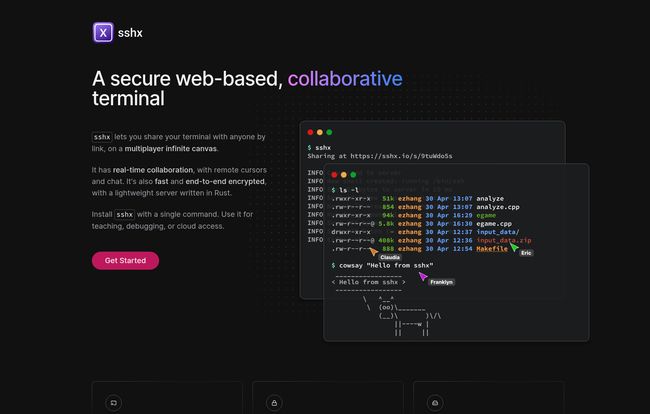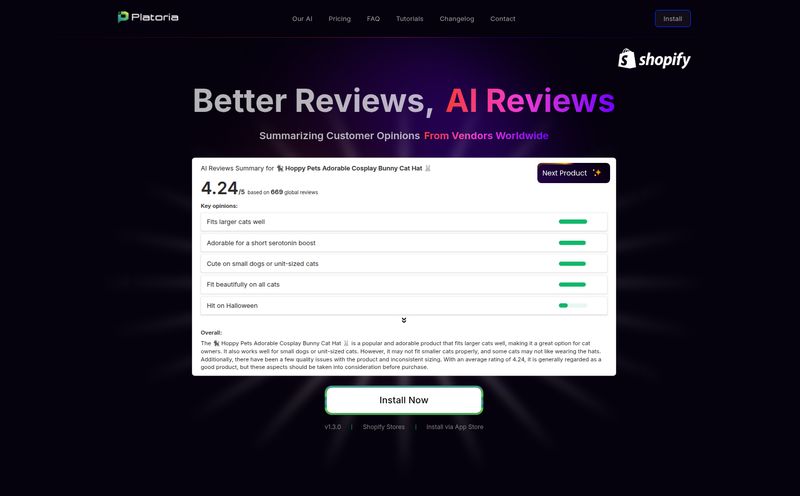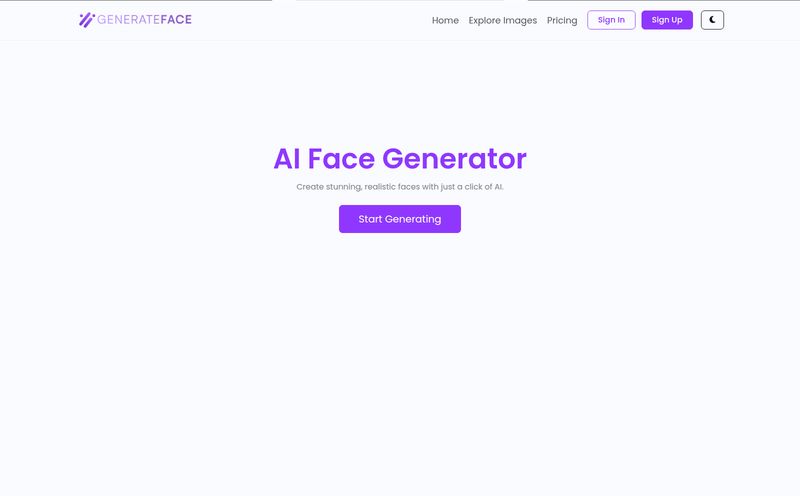We've all been there. You're on a call, trying to debug a server issue with a teammate, and the dreaded dance begins. "Okay, now type `sudo systemctl restart nginx`." A pause. "No, `systemctl`... yeah, with a C. Okay, now `nginx`. N-G-I-N-X." It's a special kind of productivity-draining purgatory that makes you question all your life choices.
For years, we've duct-taped solutions together. We've used laggy screen sharing on Zoom, which feels like watching a slideshow from 1998. We've set up shared `tmux` sessions, which is powerful if you're a command-line wizard but a bit much for a quick pairing session. We’ve even (and I shudder to admit this) passed commands back and forth in Slack like some sort of bizarre, text-based tennis match.
So when I stumbled upon a tool called sshx, my professional curiosity, born from years of this exact frustration, went into overdrive. The promise? A secure, web-based, collaborative terminal that you can share with a simple link. No hoops, no complex setups. Just... collaboration. Could this be it? The tool that finally lets us work together in the terminal as seamlessly as we do in Google Docs? I had to find out.
So, What is sshx Anyway?
At its heart, sshx is deceptively simple. You run a command in your local terminal, and it generates a unique web link. Send that link to anyone, and they can instantly see and type into your terminal right alongside you from their browser. It's not a video stream of your screen; it's a living, breathing, shared terminal session.
Think of it like this: it's not a photograph of your workshop, it's a spare key to the door. Your collaborators aren't just watching you work; they're in the room with you, able to pick up tools and help out. This distinction is everything. It shifts the dynamic from passive observation to active participation. And for anyone who's ever tried to pair program, you know that's the whole point.
The Standout Features That Genuinely Impressed Me
I’ve seen a lot of dev tools come and go. Most are just slight variations on an old theme. But sshx has a few tricks up its sleeve that feel genuinely new and, more importantly, genuinely useful.
The "Infinite Canvas" is a Game Changer
This is the feature that really made me sit up and pay attention. When your collaborator opens the sshx link, they don't just see one terminal. They see a massive, zoomable, pannable canvas. On this canvas, you can open and arrange multiple terminal windows. One for running the application, one for tailing the logs, one for running tests, and another for filesystem navigation. All at once. All in the same shared space.
Suddenly, you’re not just sharing a single command prompt; you're sharing an entire workflow. It’s like moving from a single notepad to an entire whiteboard. The potential for complex debugging sessions, infrastructure management, and even live-coding interviews is immense. It's one of those ideas that seems so obvious in hindsight you wonder why it didn't exist before.

Visit sshx
Real Collaboration with Cursors and Chat
Seeing your teammate's cursor moving around in the shared terminal is a small thing that makes a huge difference. You can see what they're pointing at, what they're about to edit. It adds a layer of non-verbal communication that's been missing from other tools. There's even a built-in chat, which is a nice touch to keep the conversation right next to the code, eliminating the need to have another app open.
Security is Baked In, Not Bolted On
Okay, sharing your terminal sounds scary. I get it. The first question any sane developer asks is, "How secure is this?" The sshx team, led by creator Eric Zhang, clearly thought about this from day one. It uses end-to-end encryption (E2EE). In plain English, this means all the data is encrypted on your machine before it's sent, and only decrypted on your collaborator's machine. The sshx server in the middle just moves gibberish around—it never sees your commands or your terminal's output.
For the tech-savvy crowd, it's also worth noting the server is written in Rust, a language famous for its focus on security and performance. This isn't just a weekend project script; it's a seriously engineered piece of software.
Getting Started with sshx
This is often where cool new tools fall flat—a complicated setup process. I was braced for the worst, but sshx surprised me again. For macOS and Linux users, it's a single, beautiful command:
curl -sSf https://sshx.io/get | shYeah, that's it. For the security folks wincing at the classic "pipe to sh" method, you can of course inspect the script first or build from source if you prefer. For Windows users, there's a downloadable executable. Once installed, you just run `sshx` to start sharing. It couldn't be much simpler. The only "catch" is that the host needs to install this little CLI tool. But your collaborators? They need nothing but a web browser. Zero friction for them.
How Does sshx Stack Up Against the Competition?
This new kid on the block enters a space with some established players. So how does it compare?
| Tool | The Good | The Not-So-Good |
|---|---|---|
| sshx | Infinite canvas, web-based for guests, E2E encrypted, built-in chat. Super easy to start. | A newer project. Requires an internet connection (obviously). |
| tmate | The reliable workhorse. Solid and well-known. Can be self-hosted. | Single terminal only. The user experience feels a bit more dated. |
| tmux + SSH | Extremely powerful and configurable. The pro's choice for session management. | Complex setup for sharing. Requires all users to have SSH access, which can be a pain to manage. |
| Zoom/Teams | Everyone already has it installed. | Laggy, passive (no real collaboration), often poor resolution. Just... no. |
In my opinion, sshx isn't just another option; it feels like an evolution. It takes the core idea of `tmate` and elevates it with a modern web UI and the brilliant infinite canvas.
The Price of Progress
So what does this wonderful new tool cost? I went looking for a pricing page, and to my surprise, I couldn't find one. One of the links on the site even led to a 404 page, which to me is a sign of a project that is actively evolving. As of this writing, sshx appears to be a completely free, open-source project. This is incredible. It's a testament to the power of open-source development and a gift to the community. You get all this power, all this convenience, for the low, low price of absolutely nothing. You can't beat that.
My Final Verdict: Should You Use sshx?
Yes. A thousand times, yes. It's rare that a tool comes along that solves such a common, nagging problem with such elegance and simplicity. The pain of remote terminal collaboration is real, and sshx is the best cure I've seen yet.
Will it replace `tmux` for my solo, day-to-day session management? Probably not, old habits die hard. But for any situation that requires more than one person in a terminal—pair programming, teaching a junior dev, emergency server debugging with a team—sshx will be the first tool I reach for. It's fast, secure, and the infinite canvas is a killer feature that genuinely improves workflow.
Give it a try. The next time you find yourself about to say "Can you see my screen?" just send an sshx link instead. You, and your teammate, will be glad you did.
Frequently Asked Questions
Is sshx free to use?
Yes, as of now, sshx is an open-source project and is completely free to use. There is no pricing information available on their website.
How is sshx different from tmate?
While both allow terminal sharing, sshx's main advantages are its modern web-based UI for collaborators, end-to-end encryption by default, and its unique "infinite canvas" feature that allows for managing multiple terminals in one shared session.
Is it safe to share my terminal with sshx?
sshx is designed with security in mind, using end-to-end encryption. This means the server facilitating the connection cannot read your terminal data. However, you are still granting someone direct access to your terminal. So, like any powerful tool, you should only share your session link with people you trust.
Do my collaborators need to install sshx?
No, and that's one of its best features. Only the person sharing their terminal (the host) needs to install the small command-line tool. Collaborators only need the link and a modern web browser.
What operating systems does sshx support?
The sshx command-line tool can be installed on macOS, Linux, and Windows. Collaborators can connect from any OS via their web browser.
Who is behind sshx?
sshx is an open-source project created by developer Eric Zhang. You can find the project's source code on GitHub.



